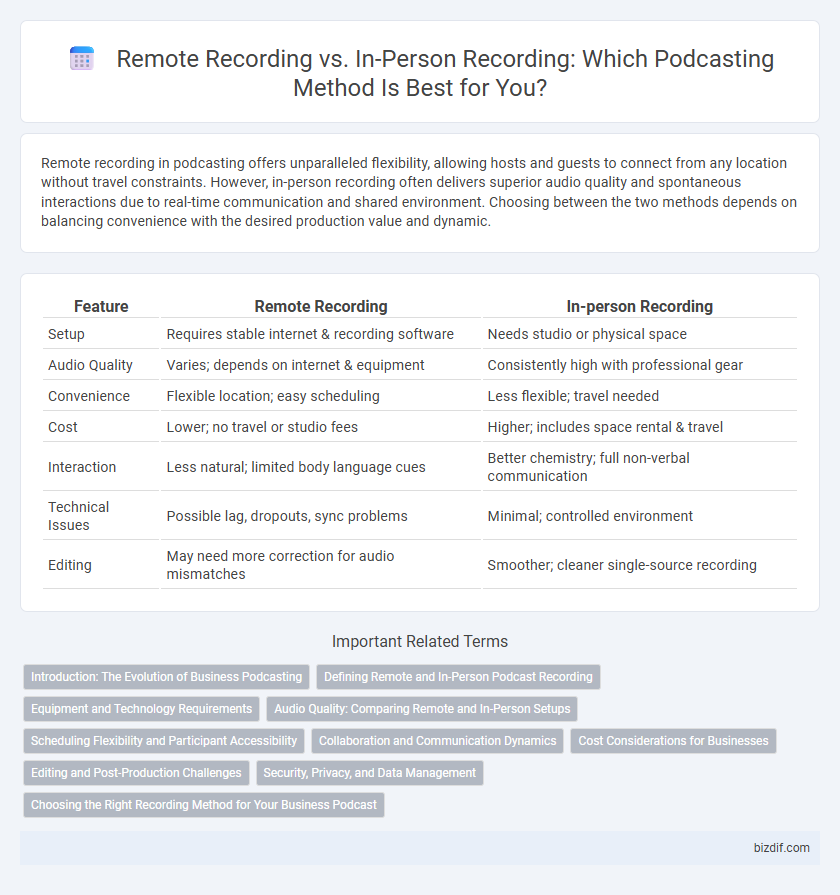Remote recording in podcasting offers unparalleled flexibility, allowing hosts and guests to connect from any location without travel constraints. However, in-person recording often delivers superior audio quality and spontaneous interactions due to real-time communication and shared environment. Choosing between the two methods depends on balancing convenience with the desired production value and dynamic.
Table of Comparison
| Feature | Remote Recording | In-person Recording |
|---|---|---|
| Setup | Requires stable internet & recording software | Needs studio or physical space |
| Audio Quality | Varies; depends on internet & equipment | Consistently high with professional gear |
| Convenience | Flexible location; easy scheduling | Less flexible; travel needed |
| Cost | Lower; no travel or studio fees | Higher; includes space rental & travel |
| Interaction | Less natural; limited body language cues | Better chemistry; full non-verbal communication |
| Technical Issues | Possible lag, dropouts, sync problems | Minimal; controlled environment |
| Editing | May need more correction for audio mismatches | Smoother; cleaner single-source recording |
Introduction: The Evolution of Business Podcasting
Business podcasting has evolved significantly with the rise of remote recording technologies, enabling hosts and guests to connect from diverse locations without sacrificing audio quality. In-person recording remains preferred for its natural interactions and controlled environments, yet remote setups offer unmatched flexibility and scalability for busy professionals. Advancements in software and hardware now bridge the gap between these methods, shaping the future of seamless and efficient business podcast production.
Defining Remote and In-Person Podcast Recording
Remote podcast recording involves hosts and guests connecting from separate locations using online platforms and digital tools, enabling flexible collaboration regardless of geography. In-person podcast recording takes place in a shared physical studio or space, allowing direct interaction, real-time communication, and controlled acoustics for higher sound quality. Both methods require specific equipment, but remote recording often relies on internet stability and software compatibility, while in-person recording depends on professional microphones and soundproof environments.
Equipment and Technology Requirements
Remote recording in podcasting relies heavily on high-quality microphones, reliable internet connections, and specialized software like Zencastr or Riverside to capture clear audio from multiple locations. In-person recording demands less dependency on connectivity but requires professional-grade mixers, multi-channel audio interfaces, and acoustically treated rooms to ensure optimal sound quality. Both methods benefit from noise-canceling headphones and digital audio workstations like Adobe Audition or Audacity for post-production editing.
Audio Quality: Comparing Remote and In-Person Setups
In-person recording typically ensures superior audio quality due to controlled environments with professional-grade microphones and soundproofing, minimizing background noise and echo. Remote recording often faces challenges like inconsistent internet connections, varied microphone quality, and ambient sounds, which can degrade audio fidelity. Advances in remote recording software with noise reduction and high-resolution audio capture are narrowing the quality gap but still generally lag behind studio conditions.
Scheduling Flexibility and Participant Accessibility
Remote recording in podcasting offers unparalleled scheduling flexibility, allowing participants from different time zones to connect without travel constraints. In-person recording provides a controlled environment but often requires coordinating physical availability and location logistics, limiting accessibility. Emphasizing remote options enhances participant diversity and convenience, optimizing production timelines and inclusivity.
Collaboration and Communication Dynamics
Remote recording in podcasting offers flexible collaboration by enabling participants to connect from diverse locations, utilizing digital tools that facilitate real-time interaction and editing capabilities. In-person recording enhances communication dynamics through immediate non-verbal cues, spontaneous dialogue flow, and shared physical presence, which often leads to more cohesive and empathetic exchanges. Both methods influence the quality of collaboration, with remote setups demanding structured coordination and in-person sessions benefiting from natural conversational rhythms.
Cost Considerations for Businesses
Remote recording significantly reduces costs for businesses by eliminating expenses related to travel, studio rental, and equipment setup. In-person recording often incurs higher costs due to location fees, transportation, and on-site technical support. Choosing remote recording enables companies to allocate budget more efficiently while maintaining production quality.
Editing and Post-Production Challenges
Remote recording often presents audio quality inconsistencies and synchronization issues that complicate editing and post-production, requiring advanced noise reduction and latency correction techniques. In-person recording enables cleaner audio capture with minimal background noise, streamlining the editing process and reducing the need for extensive audio fixes. Editors must invest more time and tools to address dropouts, delays, and varying microphone qualities in remote podcasts compared to the controlled environment of in-person sessions.
Security, Privacy, and Data Management
Remote recording in podcasting raises significant concerns around encryption, secure data transmission, and storage protocols to protect sensitive audio files from interception or unauthorized access. In-person recording enables tighter control over equipment and immediate data management, reducing risks of data breaches and ensuring enhanced privacy through physical security measures. Effective data management strategies, including end-to-end encryption and strict access controls, are critical regardless of recording method to comply with data protection regulations and safeguard intellectual property.
Choosing the Right Recording Method for Your Business Podcast
Remote recording offers flexibility and access to diverse guests worldwide, making it ideal for businesses aiming to scale their podcast audience. In-person recording ensures higher audio quality and fosters organic conversations through real-time interaction, beneficial for brands prioritizing intimate storytelling and team collaboration. Evaluating goals, resources, and guest availability helps determine the optimal recording approach for a successful business podcast.
Remote Recording vs In-person Recording Infographic

 bizdif.com
bizdif.com